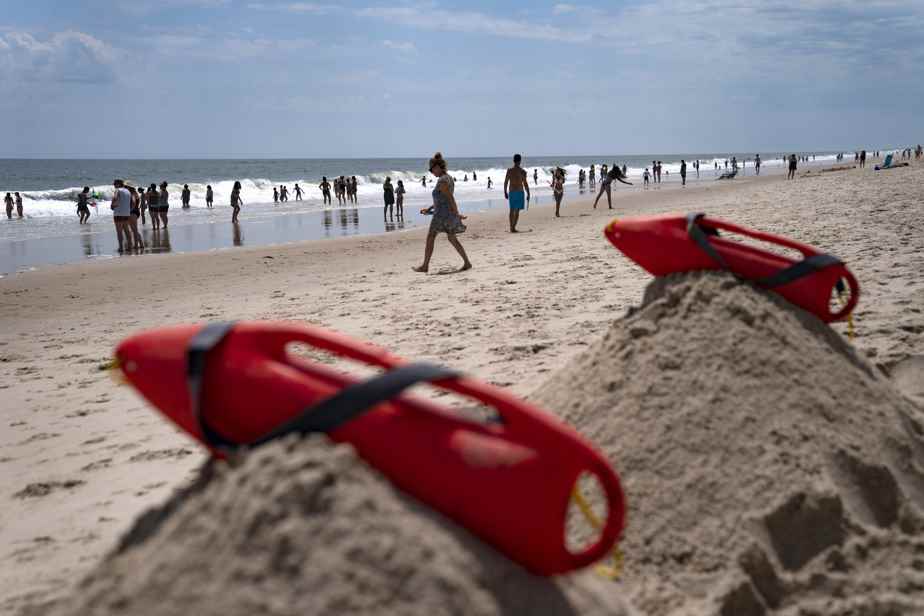(Washington) It is an animal protection success with unfortunate repercussions: great white sharks have been increasing in number in recent years off the American east coast, increasing the likelihood of unfortunate encounters with swimmers.
Posted at 6:54 a.m.
Each year, during the summer months, these predators move up the Atlantic coast of the United States, towards New England. The peak of the season occurs between August and October.
In Cape Cod, Massachusetts, the main character of “Jaws” has thus become a tourist attraction, adorning caps and t-shirts. But beaches have also already had to be temporarily closed this year because of the presence of the animal.
Nearly 300 great white sharks have been tagged over the years, and about 10 of them are already present in the area, according to Gregory Skomal, shark biologist for the state of Massachusetts. He estimates that more than a hundred great white sharks may pass through these waters each year.
Regulations have been put in place in the Atlantic since the 1990s to protect them from fishing.
“There is a general increase in population, which we think is a rebound after […] very high levels of overexploitation,” he told AFP, although it remains difficult to give a precise estimate of their number.
In addition, white sharks tend to swim closer and closer to shore to hunt one of their favorite prey: seals. They too have been protected, and their numbers are growing.
Result: more sharks, venturing closer to swimming areas.
“Shark attacks are very rare, but in the last ten years we have seen more of them,” says Gregory Skomal.
In pictures: A dead shark washes up on a beach near New York on July 20
Morsures
Dans l’État de New York, la gouverneure vient d’annoncer des patrouilles de surveillance supplémentaires, y compris par drone ou hélicoptère.
Nous continuons de surveiller la présence de requins à Long Island. Si vous vous rendez à la plage, souvenez-vous de ses consignes : nagez près du rivage et d’un sauveteur, ne vous baignez pas entre le crépuscule et l’aube, évitez d’être seul : nagez et surfez en groupe.
La gouverneure de l’État de New-York, Kathy Hochul
Sur les touristiques plages de Long Island, plusieurs morsures de requins ont déjà été rapportées par la presse – le requin blanc n’est pas forcément responsable, plusieurs autres espèces évoluant dans la région, notamment les requins-tigres et requins taureaux.
Ce nombre d’attaques est inhabituel, après trois ans sans en déplorer aucune.
Selon Gavin Naylor, directeur d’un programme de recherche sur les requins à l’Université de Floride, ce constat est lié à la présence accrue cette année de certains poissons attirant les prédateurs, possiblement à cause de courants chauds.
Mais si localement les choses peuvent ainsi fortement varier d’une année sur l’autre, au niveau mondial, environ 75 attaques de requins sont toujours enregistrées chaque année – après une baisse à environ 60 durant les deux ans de pandémie. Le nombre de décès tourne lui autour de cinq.
Ces vingt dernières années, seuls deux décès ont été déplorés au nord du Delaware aux États-Unis, à Cape Cod en 2018, et dans le Maine en 2020.
Mais à l’avenir, il est raisonnable de penser que le nombre de victimes augmentera. « Il y a davantage de requins blancs, donc la probabilité va augmenter. […] There will be more bites, ”summarized Gavin Naylor. For the moment, the general variations observed are not statistically significant, according to him.
Surfers, who venture further into the water, accounted for half of unprovoked attacks in 2021. Further south, Florida, with its many tourist beaches and tropical climate, still concentrates 60% of American attacks – and nearly 40% of global attacks.
Limit the risks
Sharks are far from the bloodthirsty beasts sometimes portrayed in movies. Studies have shown that they can mistake surfers or bathers for their usual prey – in particular white sharks, which have rather poor eyesight.
“With so many people in the water in the world, if sharks preferred to feed on human prey, we would have tens of thousands of attacks each year,” says Gregory Skomal.
With climate change, the expert expects that the increase in ocean temperatures will gradually lengthen the season during which sharks are present in the northern United States.
So what can be done to limit the risks?
An application exists so that everyone can report having seen a shark.
In the water, “look around you,” advises Nick Whitney, scientist at the New England Aquarium. If a large number of birds are hunting fish, “it probably means that sharks that also feed on them are present”.
And if bitten, the real danger is bleeding out, so it’s important to get to shore and control the bleeding until help arrives.
